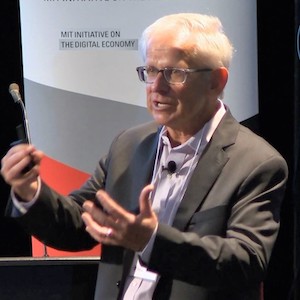The New Rules of Healthcare Platforms (Part 1): Value Creation Shifts from Pipes to Platforms
 Vince KuraitisValue for customers is created differently on platforms than by traditional product/service business models. Today we’ll present and discuss the metaphor of how traditional businesses can be thought of as “pipelines” and how these pipes differ from digital platforms.
Vince KuraitisValue for customers is created differently on platforms than by traditional product/service business models. Today we’ll present and discuss the metaphor of how traditional businesses can be thought of as “pipelines” and how these pipes differ from digital platforms.
A New Series
This post is the first in a new series: “The New Rules of Healthcare Platforms.” We’ll be writing about platform thinking, new mental models, and the new economics of platform business models and strategy. We’ll have at least seven posts to explain these new rules.
You’ll have some unlearning to do. We’ll illustrate how platform business models are fundamentally different than traditional product/service business models. To understand platforms, we need to change more than just our thinking—we need to learn new rules about how the digital world works and how platforms fit in.
From Pipes to Platforms
Traditional product or service businesses can be described as pipelines. Their value chains are linear—see the diagram below. Value is added at sequential stages before a final product or service is delivered to consumers at the end of the pipeline.
As an example, consider how cars are built and sold. You start with raw materials, e.g., steel, rubber. Raw materials are used to create automobile parts by numerous companies in the automotive supply chain. The parts are assembled in factories by auto manufacturers. The manufacturers ship the cars to dealers, who in turn sell cars to end users. Value is added in each stage of the value chain.
 Almost all incumbent healthcare businesses initially were conceptualized as traditional pipelines. For example, consider a simplified value chain of a healthcare delivery system. Outside suppliers use raw materials and knowledge to create drugs, devices, and buildings. The delivery system adds the labor of employees and affiliated clinicians; it adds infrastructure such as technology and work processes. These components are provided at the point of care to diagnose and treat patients.
Almost all incumbent healthcare businesses initially were conceptualized as traditional pipelines. For example, consider a simplified value chain of a healthcare delivery system. Outside suppliers use raw materials and knowledge to create drugs, devices, and buildings. The delivery system adds the labor of employees and affiliated clinicians; it adds infrastructure such as technology and work processes. These components are provided at the point of care to diagnose and treat patients.
In contrast, think of platform business models as triangular (see the diagram below). Platforms do not produce goods or services themselves—they make connections among stakeholders and facilitate value exchange among those stakeholders. Value is created outside the platform, and platforms are facilitators of the exchange of value among platform participants.
The value that’s exchanged by producers and consumers can take various forms. Facebook connects you with your friends. The lines between who is a producer and who is a consumer can become blurred. For example, when you create a message for your friends, you’re a producer; when you read a message in your timeline, you’re a consumer.
Other examples: Uber connects drivers and passengers. Airbnb connects people who want to rent out their property with those who’d like to rent a property for vacationing or business travel. Amazon’s e-commerce platform connects buyers and sellers. Google search connects you with websites that provide information that you’re looking for; in the process, advertisers can pay to display ads that are likely to be relevant to those searching for information.
 As compared to pipe business models, platforms are FACILITATORS of value exchange. Their role is to orchestrate the contributions of platform users and users. Value scales as a platform grows and network effects kick in.
As compared to pipe business models, platforms are FACILITATORS of value exchange. Their role is to orchestrate the contributions of platform users and users. Value scales as a platform grows and network effects kick in.
The value comes much more from the network—the community created by the platform—rather than from the technology itself. For example, value might be created from collaboration, from transactions that occur on the platform, from data capture and analytics, and/or from 3rd party apps that might be built on top of a platform.
A Healthcare Example: The Mayo Clinic Platform
Let’s consider a healthcare example—the Mayo Clinic Platform. Here’s how Gianrico Farrugia, MD—President and CEO at Mayo Clinic—described Mayo’s transition from pipeline to platform:
 Randy WilliamsOur current health care model functions as a pipeline, which is linear, highly transactional, and inflexible. The failings of this model were clear during the pandemic, where collaboration was limited and stress to individual nodes led to points of failure. This, in turn, hampered and in some cases paralyzed the entire system. A platform model of health care and ecosystem is fundamentally different. A platform is built around secure, collective resources such as a powerful analytic engine and an open ecosystem of trusted collaborators and is highly dynamic, self-learning, inherently accessible and scalable. This approach brings together providers, medical device companies, health tech startups, patients, and payers, among others, to design integrated end-to-end solutions that are supported by longitudinal clinical data and AI algorithms. A platform is purposefully collaborative and fuels innovation and access instead of limiting it.
Randy WilliamsOur current health care model functions as a pipeline, which is linear, highly transactional, and inflexible. The failings of this model were clear during the pandemic, where collaboration was limited and stress to individual nodes led to points of failure. This, in turn, hampered and in some cases paralyzed the entire system. A platform model of health care and ecosystem is fundamentally different. A platform is built around secure, collective resources such as a powerful analytic engine and an open ecosystem of trusted collaborators and is highly dynamic, self-learning, inherently accessible and scalable. This approach brings together providers, medical device companies, health tech startups, patients, and payers, among others, to design integrated end-to-end solutions that are supported by longitudinal clinical data and AI algorithms. A platform is purposefully collaborative and fuels innovation and access instead of limiting it.
Dr. John Halamka—President of the Mayo Clinic Platform—was recently interviewed on the Healthcare is Hard podcast.
Question from Keith Figlioli: I’m not so sure many people understand this idea of a platform business at Mayo. What in essence was told to you when you had taken — when you were recruited for–the job?
Answer by Dr. Halamka: You know that I live at Unity Farm Sanctuary—the largest animal sanctuary in New England and we’re an all-John Deere shop. You gotta pick John Deere, Kubota or Holland or something.
Five years ago, John Deere decided to shift from being a pipeline business to being a platform business. What does that mean? A pipeline business–I buy steel, rubber and green paint and I create a tractor that I sell and I’m done. That’s a pipeline.
A platform business is —well, what if I instrument every tractor with a dozen different sensors and every time that tractor is driven, it’s providing real-time telemetry back to a central cloud store. And I have hundreds of partners looking at that cloud store to do everything from supply chain management—how many trucks do we need in Iowa next week — to what’s the price of soybeans on a commodity market a month from now. Right, it’s financial services, it’s logistics, it’s science. Well, every time you sell a tractor, you actually are selling a telemetry production system that’s bringing more value to that central data store.
The way Mayo thought about this is could we imagine a future where every byte of data of the past–deidentified, privacy protected, ethically used—created new cures, new care pathways, new opportunities for innovation in the future? Oh, you need a platform for that! Just like John Deere needed a platform to turn tractors into an ecosystem of innovation.
Concluding Thoughts
As a preview, we’ll have a separate post later in this series on how incumbent healthcare organizations can think about and make this transition from pipe to platform. Some organizations will choose a hybrid model in which a platform can be grafted onto a traditional business model.
The mechanisms of value creation in healthcare are changing. The new refrain is “from pipes to platforms”. Reconfigured as platforms, Mayo and many other healthcare organizations will be much better positioned to facilitate and orchestrate new, innovative ways of creating value for patients.
Article Series - The New Rules of Healthcare Platforms
- Part 1: Value Creation Shifts from Pipes to Platforms
- Part 2: Pipe Scale vs. Platform Scale
- Part 3: Platform Thinking Expands from “Technology” to Business Model & Strategy
- Part 4: APIs Enable the Platforming of Healthcare
This article was originally published in The Healthcare Platform Blog. It is republished by Open Health News under the terms of the Creative Commons Attribution-Share Alike 3.0 Unported License (CC BY-SA 3.0). The original copy of the article can be found here.
- Tags:
- analytic engine
- artificial intelligence algorithms
- collective resources
- community created by the platform
- data analytics
- data capture
- digital platforms
- economics of platform business models
- economics of platform business strategy
- ecosystem of innovation
- facilitators of value exchange
- Gianrico Farrugia
- health tech startups
- healthcare delivery system
- integrated end-to-end solutions
- John Deere
- John Halamka
- Keith Figlioli
- longitudinal clinical data
- Mayo Clinic Platform
- medical device companies
- network effects
- open ecosystem
- platform business models
- platform model of health care platform model of health ecosystem
- platform thinking
- Randy Williams
- The Healthcare Platform Blog
- The New Rules of Healthcare Platforms
- traditional product business models
- traditional service business models
- transactional collaboration
- trusted collaborators
- Unity Farm Sanctuary
- value for customers
- Vince Kuraitis
- Login to post comments